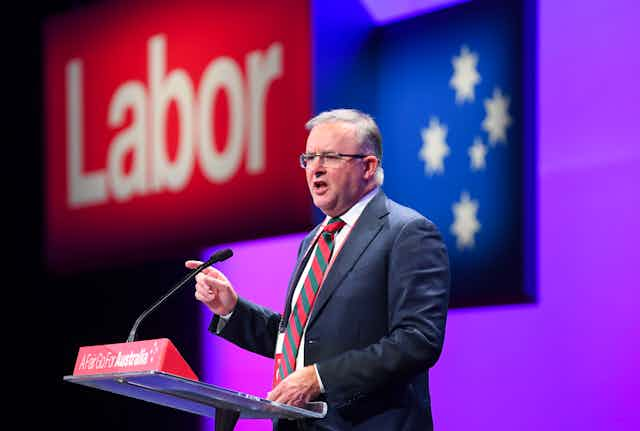Party members, unions and politicians will meet in Brisbane on Thursday when Labor’s national conference begins. The event is where Labor’s federal policy direction is hashed out. This year, Prime Minister Anthony Albanese will be under pressure from within the party to boost Labor’s action on climate change.
This is federal Labor’s first conference since forming government in May last year. Following that win, there was enormous goodwill for the party’s political platform – both from within Labor’s membership and the broader community. The sentiment extended to Labor’s modest promised action on climate change, which seemed like a giant leap forward after the climate policy desert of the Coalition years.
Since the election, however, the world has changed. The climate emergency is accelerating with breathtaking speed. And the frightening frequency of climate-related disasters further validate the agendas of the Greens and the teal independents as they push the government for ambitious climate action.
So let’s take a look at where the Albanese government stands on climate policy ahead of its national conference, and where it needs to go before the next election.

What has Labor done on climate change?
Labor’s climate action has been a vast improvement on the very low bar set by the previous Coalition government. But there’s plenty of room for improvement.
For example, Labor enshrined into law an emissions reduction target of 43% by 2030 and net-zero emissions by 2050. But as others have noted, more cuts are needed for Australia to do its share on emissions reduction under the Paris Agreement.
Labor’s strengthening of the safeguard mechanism will go some way to curbing industrial emissions. But the government continues to support new mining and energy projects.
This week, thousands of Labor’s rank-and-file members will use the national conference to pressure Albanese on climate action. The push, backed by 350 Labor branches, will call for a windback on land clearing and native forest logging (which would help reach emissions-reduction goals), and more subsidies for renewable energy.
That’s not the only internal pressure Albanese faces, however. The Construction Forestry Maritime Mining and Energy Union is reportedly set to oppose the push to abandon native forest harvesting.
Read more: Why are so many climate records breaking all at once?
The bigger picture
Aside from its internal juggling act, Labor must significantly enhance its climate credentials before the next election to fight off teal independents and the Greens.
Last year’s watershed federal election resulted in six progressive “teal” female independents entering parliament, by displacing male Liberal Party incumbents from inner-city blue ribbon seats. The new MPs joined independent Warringah MP Zali Steggall, who was elected in 2019.
The wave of teal victories was seen in part as punishment for the Liberals over climate inaction.

The Greens party, too, had its best-ever federal election result.
It won four lower house seats – Melbourne, which party leader Adam Bandt retained, and three new seats in inner Brisbane. The party says the success gives it a mandate to push the government harder on climate change.
Since being elected, the Greens and the crossbench – including the teals and independent senator David Pocock – have all pressured Labor to strengthen its climate agenda.
For instance, the crossbenchers and the Greens secured amendments to Labor’s Climate Change Bill. Pocock and the Greens also won changes to the so-called “safeguard mechanism”, which applies to emissions from Australia’s most polluting companies.
The crossbench pressure on the Albanese government is unlikely to let up. And Labor MPs could be battling new teal challengers at the 2025 election.
Meanwhile, the Coalition has given up on providing any real opposition on climate and energy policy – putting most of its bets on irrational support for nuclear power.

Labor’s climate challenge
Australians have watched with alarm in recent weeks as the Northern Hemisphere summer went haywire. Air and ocean temperature records have tumbled and deadly wildfires have destroyed vast swathes of land from the Mediterranean to Hawaii.
Australia, after an unseasonably warm winter, is heading into a hot, dry El Niño summer.
What’s more, climate change is becoming a key component in the cost-of-living crisis. Insurance premiums have reportedly jumped 50% in the last year in high-risk parts of Australia, such as flood-prone areas.
Labor was bound to the climate policies it took to the last election. But there’s now a persuasive argument that climate conditions have dramatically shifted – and more radical policies are needed.
National Labor party conferences do not hold the primacy they once did, because the caucus and cabinet now hold more sway. But they remain the key avenue for grassroots members to influence party policy.
More significant government measures on climate change would satisfy the thousands of rank-and-file Labor members who want action. It would also help shore up Labor against progressive challengers at the next election.

